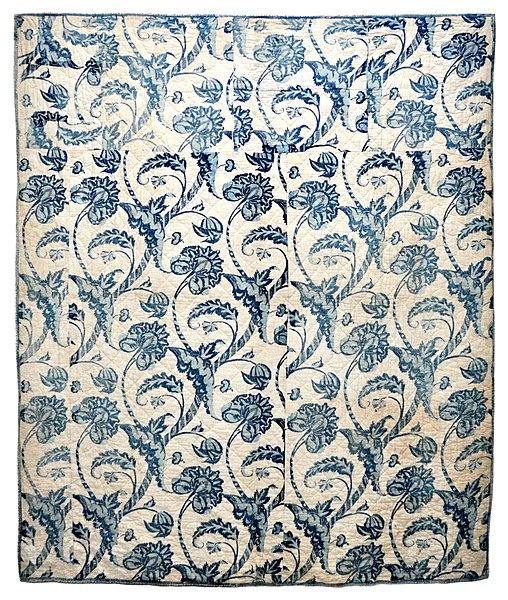Julia Sneden's Magic Moments at the End of Summer
by Julia Sneden
This early American wholecloth quilt was made in the Colonial period. The blue resist fabric includes bold, fanciful botanical motifs. Collection of Bill Volckening; Wikipedia
For my family (and I suspect for many others), summer’s end seems to be fraught with ambivalent feelings about the seasonal changes. We say a lingering, regretful farewell to quiet days, but because we are a family of teachers, we also feel a surge of energy and excitement in anticipation of the new school term. We swelter in the dog days, but then a hint of cooler weather brings the first stirrings of anxiety over what winter will bring. We say sad farewells to visiting family members, but as soon as they are out the door, we begin looking forward to the holiday visits that are not too far away. It’s not exactly a sad time, this folding in of summer’s story, but any change is unsettling, and change is definitely in the air.
There are a number of small ceremonies we perform as we see summer out. We put away hot weather clothing and dig out sweaters. We fold up the light blankets for storage, and hang the quilts out to air. After a summer of serving simple salads, we try to recall recipes for warm and warming suppers. We clean and put away the lawn mower, and pull up plants that have already shriveled in the garden.
These little observances are fairly universal, but most of us also have a few small, idiosyncratic gestures to mark the end of summer. One of my children, for instance, always jumped back into the lake at the end of his last vacation swim, and took one small pebble from the bottom to carry home for remembrance, his "souvenir of the trail," we called it.
My own favorite activity to mark summer's end is one that I discovered during my years as a classroom teacher: finding the caterpillars of Monarch butterflies, bringing them indoors to observe their metamorphoses, and seeing them off on their annual trip south to Mexico for the winter. It's not an expensive or complicated enterprise. Anyone who can identify milkweed growing in a nearby field will probably be able to find Monarch caterpillars in late August or early September. All you need is a jar of water, a pair of scissors, and a bit of patience. This is a great activity to share with your favorite child, but it's also a rewarding experience if the only person involved in it is yourself.
Pages: 1 · 2
More Articles
- Ferida's Wolff's Backyard: The Snow Turned Into Snowy Rain As It Fell From The Trees. Still Lovely ...
- Ferida Wolff's Backyard: Shifting Seasons: We Need to Remember That We Are Strong Underneath, That Things Change and That the World is Flexible.
- Ferida Wolff's Backyard: Awesome Goldfinches, Part of the Incredible Possibilities That Nature Might Offer
- Ferida Wolff's Backyard: Nature’s Jigsaw Puzzles
- Rebecca Louise Law: Awakening on View at Honolulu Museum of Art
- Ferida Wolff's Backyard: Dandelion Landing
- Ferida's Wolff's Backyard: A Nest!
- Ferida Wolff Writes: Winter to Spring
- Ferida's Wolff's Backyard: Geese Coming Home
- Ferida Wolff's Backyard: Lots and Lots of Boxelders






